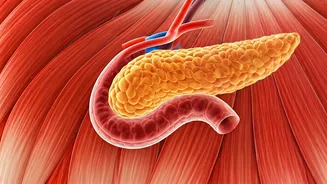Weight Loss Myths
The common goal of losing weight often overshadows the more important aspect: losing fat. It's perfectly feasible to shed fat while maintaining, or even
building, muscle mass. This is often the healthier route. Combining resistance training with moderate calorie restriction has shown better blood sugar control compared to dieting alone. Muscle tissue acts like a glucose sponge, so more muscle means more efficient sugar use by the body. Focusing on body composition helps individuals see improvements in their metabolic health over time. You might notice your clothes fit better and your energy levels increase even if the scale stays the same.
Dangers of Visceral Fat
Not all fat is created equal. Subcutaneous fat, located just under the skin, is relatively harmless. The real trouble lies with visceral fat, which accumulates around vital organs like the liver, pancreas, and intestines. People with higher levels of visceral fat are two to three times more likely to develop insulin resistance. Excess fat in the liver is particularly dangerous, as it continues to release glucose into the bloodstream even when blood sugar is already high, worsening insulin resistance. Reducing liver fat by just 25% can improve fasting glucose and HbA1c levels, even without significant weight changes. This is why some individuals with a normal weight can still develop type 2 diabetes, a condition sometimes called “metabolically obese normal weight” (MONW), due to hidden visceral fat.
Scale Isn't the Truth
When people cut calories or start exercising, the initial weight loss can be deceiving. The scale drops, but this reflects changes in water, glycogen (stored carbohydrates), and sometimes muscle mass. In the first few weeks of dieting, water loss accounts for most of the weight drop. The body uses glycogen for energy, and each gram of glycogen releases about three grams of water. You can lose several kilograms without actually reducing fat stores. Muscle loss during dieting can worsen blood sugar control. Muscle tissue is crucial for using glucose, so less muscle means less glucose uptake, leading to higher blood sugar levels. While overall weight may decrease, your metabolic health may not necessarily improve.
Prioritizing Fat Loss
Fat loss is key to improving insulin sensitivity. Reducing fat, especially around the abdomen and liver, dramatically improves how the body handles blood sugar. This approach helps restore insulin response and promotes better metabolic health long-term. Focusing on fat reduction over the scale leads to lasting health benefits. Fat loss refers specifically to the reduction of adipose tissue, especially the visceral fat that surrounds internal organs. This type of fat is closely linked with insulin resistance, a condition where cells no longer respond properly to insulin. A 10% reduction in body fat increased insulin sensitivity by nearly 30%, even when total body weight remained stable. Shrinking fat cells release fewer inflammatory molecules and fatty acids, which interfere with insulin signalling. Fat loss also benefits mitochondrial function, allowing muscle cells to use glucose more efficiently. This is why even modest fat reduction, without dramatic weight loss, can lead to better blood sugar levels and energy balance.
Sustainable Fat Loss
To reduce fat effectively and improve insulin sensitivity, it’s essential to focus on sustainable changes rather than quick fixes. Extreme calorie restriction or rapid “detox” plans can cause muscle loss, fatigue, and rebound weight gain. Aim for a gradual fat loss of 0.5–1% of body weight per week through a combination of diet, exercise, and recovery. Key strategies include: incorporating strength and aerobic training, eating protein-rich foods, focusing on balanced meals, sleeping well, and avoiding extreme diets. When it comes to managing health or reducing the risk of type 2 diabetes, most people talk about losing weight. But weight loss and fat loss are not the same thing and understanding this difference can make all the difference for insulin sensitivity and long-term metabolic health. While the scale measures overall body mass, only fat loss, especially from around the abdomen and liver, improves how the body handles blood sugar. Studies show that reducing fat rather than just weight is what truly helps restore the body’s ability to respond to insulin effectively.












